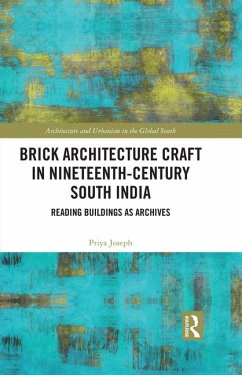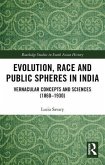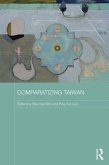- Gebundenes Buch
- Merkliste
- Auf die Merkliste
- Bewerten Bewerten
- Teilen
- Produkt teilen
- Produkterinnerung
- Produkterinnerung
This book explores brick architecture of the nineteenth century in South India, through the lens of tectonics and materiality.
Andere Kunden interessierten sich auch für
![India's Princely States India's Princely States]() Waltraud Ernst / Biswamoy Pati (eds.)India's Princely States187,99 €
Waltraud Ernst / Biswamoy Pati (eds.)India's Princely States187,99 €![Russian Fractals in Indigenous Artifacts Russian Fractals in Indigenous Artifacts]() Abdul Karim BanguraRussian Fractals in Indigenous Artifacts103,99 €
Abdul Karim BanguraRussian Fractals in Indigenous Artifacts103,99 €![Evolution, Race and Public Spheres in India Evolution, Race and Public Spheres in India]() Luzia SavaryEvolution, Race and Public Spheres in India196,99 €
Luzia SavaryEvolution, Race and Public Spheres in India196,99 €![An Appeal to the Ladies of Hyderabad An Appeal to the Ladies of Hyderabad]() Benjamin B CohenAn Appeal to the Ladies of Hyderabad27,99 €
Benjamin B CohenAn Appeal to the Ladies of Hyderabad27,99 €![Remembering Genocide Remembering Genocide]() Remembering Genocide196,99 €
Remembering Genocide196,99 €![Comparatizing Taiwan Comparatizing Taiwan]() Comparatizing Taiwan196,99 €
Comparatizing Taiwan196,99 €![Human Exhibitions Human Exhibitions]() Rikke AndreassenHuman Exhibitions177,99 €
Rikke AndreassenHuman Exhibitions177,99 €-
-
-
This book explores brick architecture of the nineteenth century in South India, through the lens of tectonics and materiality.
Produktdetails
- Produktdetails
- Verlag: Taylor & Francis
- Seitenzahl: 180
- Erscheinungstermin: 18. März 2025
- Englisch
- Abmessung: 234mm x 156mm
- Gewicht: 530g
- ISBN-13: 9781032860183
- ISBN-10: 1032860189
- Artikelnr.: 72004570
- Herstellerkennzeichnung
- Libri GmbH
- Europaallee 1
- 36244 Bad Hersfeld
- gpsr@libri.de
- Verlag: Taylor & Francis
- Seitenzahl: 180
- Erscheinungstermin: 18. März 2025
- Englisch
- Abmessung: 234mm x 156mm
- Gewicht: 530g
- ISBN-13: 9781032860183
- ISBN-10: 1032860189
- Artikelnr.: 72004570
- Herstellerkennzeichnung
- Libri GmbH
- Europaallee 1
- 36244 Bad Hersfeld
- gpsr@libri.de
Priya Joseph teaches at Srishti Manipal Institute of Art, Design and Technology, MAHE, Bengaluru, India, and is an architect by training. Her work transects architectural history, urban ecologies, art and design in the urban, and material culture. She has published widely on architecture, and materiality, including Terracotta People (2024) and Rupturing Terracotta: Entangled Exchanges of the Hand and the Machine in South India (2022).
List of figures List of abbreviations Acknowledgements Glossary Part 1: Reading the Archive Chapter 1: The Humble Brick: Material for a Billion
Brick: Construction Material for a Billion
The Decolonial Lens
Hybridity
Standardisation, Mechanisation, Automation
Brick: Contemporary Challenges
Structure and Themes of the Book Chapter 2: Precolonial to Colonial: History of Brick in the Indian Subcontinent
Bricks: Indus to the Nineteenth-century Colonial India
Regional Variations
Missionaries and Factories
Terracotta/Fired Earth: Colonisers Trailing the Missionaries
Terracotta Brick and Tile Industry in Mangalore
The Basel Mission Printing Press
Other Terracotta Tiles Chapter 3: Nineteenth-Century Conversations between the Indigenous and the Colonial
Introduction
Methods and Manuals
The Anthropology of Bricks: Brick-makers of Burma
Coloured Bricks
Well Sinkers: Manual to Mechanised
Brick, Mortar and Plasters of the Nineteenth-century India
Colonial Coercion
The Old and the New Archives Part 2: Drawing the Archives Chapter 4: Why Read and Draw Buildings as Archives?
Traditional Taxonomy in Architectural History
What is an Archive?
Technique and Material as an Anchor of Architectural Analysis
Brick in Focus
The Hidden Historical Archives in the Tectonic Making of Architecture
Tracing the Intersections
A Case Study Method
Manual Measured Drawings Versus Advanced Digital Techniques
Handmade versus Machine-made
The Decolonial Shift Chapter 5: Hybridity: Materiality and Tectonic of the Chatrams of Thanjavur
Introduction
Cases in Brick
Chatrams of Thanjavur - Why are the Chatrams of Thanjavur Important?
Sculptural and Assembled Derivation in Architecture
Muktambal (1801) and Yamunambal Chatrams, Thanjavur (1761) - Typology - Details in Brick
Vennar (1779), Kalyana Mahal (1832) and Shreyas Chatrams (1837) - Details in Brick - Column, Openings and Walls in Brick
Hybridity Chapter 6: Brick Tectonics of a Church, a School and a Market
Rosary Church of Shettihalli, 1810-1880 - Brick Ruins and the Story of Technology - Typology and Drawings - Elements of Architecture
Tracing Hybridity Through Drawing
The Red Kirk at Bengaluru, 1864
Fort School, Bengaluru, 1907 - Typology and Drawings - Elements of Architecture - Material Technique and Columns
New Material and Traditional Skills
Devaraja Market, Mysore, Karnataka, 1900 - Typology and Drawings - Elements of Architecture
Roofs with Steel Chapter 7: Future: Contemporary Architecture with Bricks and Adobe
Standardisation: A Consequence of Nineteenth-century Mass Production
Twentieth-century Experiments in Brick
Contemporary Brick Architecture in South Asia
Brick in the Forefront
Conclusion Index
Brick: Construction Material for a Billion
The Decolonial Lens
Hybridity
Standardisation, Mechanisation, Automation
Brick: Contemporary Challenges
Structure and Themes of the Book Chapter 2: Precolonial to Colonial: History of Brick in the Indian Subcontinent
Bricks: Indus to the Nineteenth-century Colonial India
Regional Variations
Missionaries and Factories
Terracotta/Fired Earth: Colonisers Trailing the Missionaries
Terracotta Brick and Tile Industry in Mangalore
The Basel Mission Printing Press
Other Terracotta Tiles Chapter 3: Nineteenth-Century Conversations between the Indigenous and the Colonial
Introduction
Methods and Manuals
The Anthropology of Bricks: Brick-makers of Burma
Coloured Bricks
Well Sinkers: Manual to Mechanised
Brick, Mortar and Plasters of the Nineteenth-century India
Colonial Coercion
The Old and the New Archives Part 2: Drawing the Archives Chapter 4: Why Read and Draw Buildings as Archives?
Traditional Taxonomy in Architectural History
What is an Archive?
Technique and Material as an Anchor of Architectural Analysis
Brick in Focus
The Hidden Historical Archives in the Tectonic Making of Architecture
Tracing the Intersections
A Case Study Method
Manual Measured Drawings Versus Advanced Digital Techniques
Handmade versus Machine-made
The Decolonial Shift Chapter 5: Hybridity: Materiality and Tectonic of the Chatrams of Thanjavur
Introduction
Cases in Brick
Chatrams of Thanjavur - Why are the Chatrams of Thanjavur Important?
Sculptural and Assembled Derivation in Architecture
Muktambal (1801) and Yamunambal Chatrams, Thanjavur (1761) - Typology - Details in Brick
Vennar (1779), Kalyana Mahal (1832) and Shreyas Chatrams (1837) - Details in Brick - Column, Openings and Walls in Brick
Hybridity Chapter 6: Brick Tectonics of a Church, a School and a Market
Rosary Church of Shettihalli, 1810-1880 - Brick Ruins and the Story of Technology - Typology and Drawings - Elements of Architecture
Tracing Hybridity Through Drawing
The Red Kirk at Bengaluru, 1864
Fort School, Bengaluru, 1907 - Typology and Drawings - Elements of Architecture - Material Technique and Columns
New Material and Traditional Skills
Devaraja Market, Mysore, Karnataka, 1900 - Typology and Drawings - Elements of Architecture
Roofs with Steel Chapter 7: Future: Contemporary Architecture with Bricks and Adobe
Standardisation: A Consequence of Nineteenth-century Mass Production
Twentieth-century Experiments in Brick
Contemporary Brick Architecture in South Asia
Brick in the Forefront
Conclusion Index
List of figures List of abbreviations Acknowledgements Glossary Part 1: Reading the Archive Chapter 1: The Humble Brick: Material for a Billion
Brick: Construction Material for a Billion
The Decolonial Lens
Hybridity
Standardisation, Mechanisation, Automation
Brick: Contemporary Challenges
Structure and Themes of the Book Chapter 2: Precolonial to Colonial: History of Brick in the Indian Subcontinent
Bricks: Indus to the Nineteenth-century Colonial India
Regional Variations
Missionaries and Factories
Terracotta/Fired Earth: Colonisers Trailing the Missionaries
Terracotta Brick and Tile Industry in Mangalore
The Basel Mission Printing Press
Other Terracotta Tiles Chapter 3: Nineteenth-Century Conversations between the Indigenous and the Colonial
Introduction
Methods and Manuals
The Anthropology of Bricks: Brick-makers of Burma
Coloured Bricks
Well Sinkers: Manual to Mechanised
Brick, Mortar and Plasters of the Nineteenth-century India
Colonial Coercion
The Old and the New Archives Part 2: Drawing the Archives Chapter 4: Why Read and Draw Buildings as Archives?
Traditional Taxonomy in Architectural History
What is an Archive?
Technique and Material as an Anchor of Architectural Analysis
Brick in Focus
The Hidden Historical Archives in the Tectonic Making of Architecture
Tracing the Intersections
A Case Study Method
Manual Measured Drawings Versus Advanced Digital Techniques
Handmade versus Machine-made
The Decolonial Shift Chapter 5: Hybridity: Materiality and Tectonic of the Chatrams of Thanjavur
Introduction
Cases in Brick
Chatrams of Thanjavur - Why are the Chatrams of Thanjavur Important?
Sculptural and Assembled Derivation in Architecture
Muktambal (1801) and Yamunambal Chatrams, Thanjavur (1761) - Typology - Details in Brick
Vennar (1779), Kalyana Mahal (1832) and Shreyas Chatrams (1837) - Details in Brick - Column, Openings and Walls in Brick
Hybridity Chapter 6: Brick Tectonics of a Church, a School and a Market
Rosary Church of Shettihalli, 1810-1880 - Brick Ruins and the Story of Technology - Typology and Drawings - Elements of Architecture
Tracing Hybridity Through Drawing
The Red Kirk at Bengaluru, 1864
Fort School, Bengaluru, 1907 - Typology and Drawings - Elements of Architecture - Material Technique and Columns
New Material and Traditional Skills
Devaraja Market, Mysore, Karnataka, 1900 - Typology and Drawings - Elements of Architecture
Roofs with Steel Chapter 7: Future: Contemporary Architecture with Bricks and Adobe
Standardisation: A Consequence of Nineteenth-century Mass Production
Twentieth-century Experiments in Brick
Contemporary Brick Architecture in South Asia
Brick in the Forefront
Conclusion Index
Brick: Construction Material for a Billion
The Decolonial Lens
Hybridity
Standardisation, Mechanisation, Automation
Brick: Contemporary Challenges
Structure and Themes of the Book Chapter 2: Precolonial to Colonial: History of Brick in the Indian Subcontinent
Bricks: Indus to the Nineteenth-century Colonial India
Regional Variations
Missionaries and Factories
Terracotta/Fired Earth: Colonisers Trailing the Missionaries
Terracotta Brick and Tile Industry in Mangalore
The Basel Mission Printing Press
Other Terracotta Tiles Chapter 3: Nineteenth-Century Conversations between the Indigenous and the Colonial
Introduction
Methods and Manuals
The Anthropology of Bricks: Brick-makers of Burma
Coloured Bricks
Well Sinkers: Manual to Mechanised
Brick, Mortar and Plasters of the Nineteenth-century India
Colonial Coercion
The Old and the New Archives Part 2: Drawing the Archives Chapter 4: Why Read and Draw Buildings as Archives?
Traditional Taxonomy in Architectural History
What is an Archive?
Technique and Material as an Anchor of Architectural Analysis
Brick in Focus
The Hidden Historical Archives in the Tectonic Making of Architecture
Tracing the Intersections
A Case Study Method
Manual Measured Drawings Versus Advanced Digital Techniques
Handmade versus Machine-made
The Decolonial Shift Chapter 5: Hybridity: Materiality and Tectonic of the Chatrams of Thanjavur
Introduction
Cases in Brick
Chatrams of Thanjavur - Why are the Chatrams of Thanjavur Important?
Sculptural and Assembled Derivation in Architecture
Muktambal (1801) and Yamunambal Chatrams, Thanjavur (1761) - Typology - Details in Brick
Vennar (1779), Kalyana Mahal (1832) and Shreyas Chatrams (1837) - Details in Brick - Column, Openings and Walls in Brick
Hybridity Chapter 6: Brick Tectonics of a Church, a School and a Market
Rosary Church of Shettihalli, 1810-1880 - Brick Ruins and the Story of Technology - Typology and Drawings - Elements of Architecture
Tracing Hybridity Through Drawing
The Red Kirk at Bengaluru, 1864
Fort School, Bengaluru, 1907 - Typology and Drawings - Elements of Architecture - Material Technique and Columns
New Material and Traditional Skills
Devaraja Market, Mysore, Karnataka, 1900 - Typology and Drawings - Elements of Architecture
Roofs with Steel Chapter 7: Future: Contemporary Architecture with Bricks and Adobe
Standardisation: A Consequence of Nineteenth-century Mass Production
Twentieth-century Experiments in Brick
Contemporary Brick Architecture in South Asia
Brick in the Forefront
Conclusion Index








